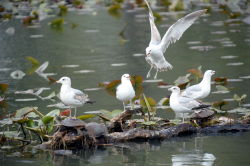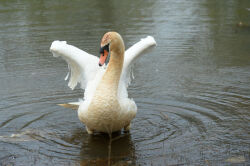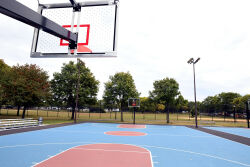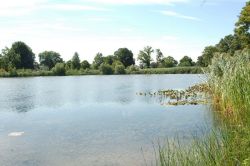Baisley Pond Park
Lakeview Lane Playground
Located on the edge of Baisley Pond Park and bounded on one side by Lakeview Lane, both the playground and street are named for their view of Baisley Pond, which lies near the southern Queens neighborhood of Springfield Gardens, just north of Kennedy Airport.
Although the park is used mostly for recreational sports, it still remains a vital natural habitat for many species of plant and animal life. Besides its fabled lily pads, the pond contains red-eared sliders, snapping turtles, musk turtles, and bullfrogs. Visitors can count eight different varieties of dragonfly buzzing in the lush shrubbery. Of course, the avian life of the park is equally spectacular. In the winter, Canadian geese, mallards, ducks, shovelers, coots, grebes, and gulls make their home here. In the summer, blackbirds, cormorants, herons, egrets, doves, mockingbirds, robins, starlings, warblers, cardinals, and sparrows forage and breed in the area.
The pond is named for David Baisley, a local farmer who owned this land and operated a mill on the pond in the early 19th century. The 30-acre pond was first formed in the 18th century, when farmers dammed three streams in order to power their grain mill. A contemporary description refers to the “clearness and sweetness of water, how beautifully the birds sing, and how the turtles leave their tracks as they crawl out of the mud.” Supposedly, some lily pads that covered the pond were up to eight feet long and three inches thick.
The City of Brooklyn acquired Baisley Pond for use as a water source for Brooklyn in 1852. While dredging the bottom, workers found the remains of an American mastodon (Mammut americanum) that lived here 10,000 years ago. Today, a climbable sculpture of a mastodon stands at Sutphin Boulevard and 125th Avenue. It commemorates the special discovery and provides children with a unique playmate.
In 1914, the City of New York transferred the northern half of the site to Parks. Five years later, the park first opened to the public. During the Great Depression of the 1930s, Parks Commissioner Robert Moses (1888-1981) and the Works Progress Administration constructed recreational facilities in the park, including a boat landing, several playgrounds, tennis and handball courts, baseball diamonds, and a football field. Urbanization of the area continued and intensified after World War II, with the construction of the Cedar Manor Co-Op, Baisley Park Houses, and Baisley Garden. When John F. Kennedy International Airport (then called Idlewild) opened just south of here in 1948, commercial activity in the area increased tremendously.
The southern portion of the property remained neglected until 1984, when Parks Commissioner Henry J. Stern and the local community were finally able to beautify the remaining grounds around the pond, and unify the park property. The newly reconstructed area included more tennis and handball courts, a track, an athletic field, cricket mounds, basketball courts, and the Lakeview Lane Playground.
Lakeview Lane Playground underwent a $760,000 renovation, completed in 1999 with funding provided jointly by City Council Member Thomas J. White and Queens Borough President Claire Shulman. The renovation included reconstruction of the playground and paths adjacent to Lakeview Lane. The playground features play equipment with safety surfacing, swing sets, benches, a drinking fountain, lily pad art, and sunflower spray showers with giant lily pads in ground.
Check out your park's Vital Signs
Clean & Safe
Green & Resilient
Empowered & Engaged Users
Share your feedback or learn more about how this park is part of a
Vital Park System










